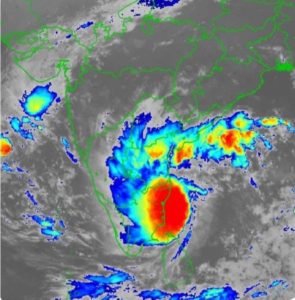
Image: India Meteorological Department
Turbulence around Bay of Bengal
Should I be worried about flying in bad weather?
To some air travelers, bumpiness in the skies or turbulence is a major concern to them.
A journalist friend recently asked me about these on her forthcoming journey. I had demonstrated a simulated turbulent flight aboard a flight simulator with her before. This time it was going to be real.
It was about 8 hours before her flight when she contacted me with a weather map (see above) showing a severe depression beside her route from Singapore to London.
She wrote, “Hello Captain Lim. There are huge depressions forming and thunderstorms are forecasted over the Bay of Bengal and southeast India when I fly in the evening. Should I postpone my flight?”
Ah, that tickled my mind about an incident at the Bay of Bengal years back when I flew from London to Kuala Lumpur. I was the second team of a 4-man crew and was still sleeping in the pilot bunk. All of a sudden, I was tossed violently around but fortunately I was held back by my bunk belt.
I later found out the other crew had inadvertently flown over the tip of a thunderstorm cloud at 37,000 feet
As a general rule, pilots must stay at least 20 nautical miles from a thundery (cumulonimbus) cloud, depicted red on the weather radar map.
I checked the weather map she sent me and found that her route would take her to the right of the cloud. I then reassured her that it would not be very turbulent as the captain would make every effort to avoid the weather.
Turbulence is a natural occurrence when flying and should be expected and not dreaded. The trick is to understand it.
I explained to her that it is safe to fly in turbulence as long as she is securely strapped to her seat belt.
Turbulence is only an issue of discomfort rather than of safety.
To some, turbulence can be so traumatic that it can cause fear of flying.
After having arrived at the destination, she related to me that her flight by the Bay of Bengal was relatively calm. However. she was met with extremely rough weather over the Arabian Sea.
Turbulence may be like roller coaster rides, but it cannot generally break the wings.
For example, the Boeing 787’s wings can flex up to 25 feet upwards before falling. The aircraft designer calculated the maximum stress they can anticipate a wing would experience in flight and then designed it to withstand 50% more for safety.
After having explained that her flight by the Bay of Bengal would be generally fine, I left the decision to her to postpone or proceed on her journey.
Forecasting smooth weather all the way on a long flight is not easy. I could not predict the stability of the air ahead accurately, especially when she later told me of her rough experience over the Arabian Sea. Despite that, she related to me she was calm because of what I told her.
I felt happy that I have at least made a scary flier to be less fearful of turbulence now.
1. See video of a Boeing 787 Dreamliner: Ultimate-load wing flex test here
2. View a 12:15 min Video below..
Fear of flying help video by Virgin Flying Without Fear Team – YouTube